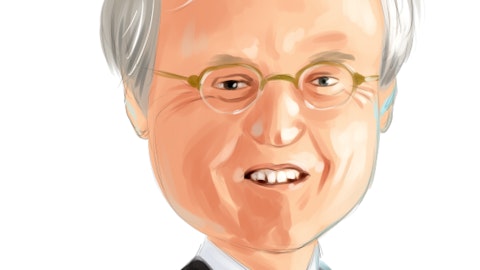Catherine Mealor: I just want to start on just the margin and thinking about big picture outlook. There’s been a lot of the narrative, I think, from a lot of the other banks we’ve seen this quarter has been that — this quarter or maybe next is where we’re seeing peak NIM and then the margins are kind of flat to maybe even down as you move through back half of the year as deposit costs continue to ramp. As I think about you all, you’ve had some of the higher betas early on. And so, how do you think about that just kind of big picture holistically? Is there an argument to say that you still have more room for margin expansion as we kind of move through the year? Or are you in the campus with most of your peers where we’re kind of at or near peaking NIM today? Thanks.
Charles Levingston: Sure then, Catherine. I think, it will be pretty significantly dependent on Fed action. Right now, I think futures markets are suggesting a pretty high probability in the mid to high 90%-s that we’re going to see 25 basis points in February and then another 25 in March. We’re still asset sensitive. Over a 12-month period, 100 basis point shock on a static balance sheet sees net interest income expansion of 9.9%, almost 10%. So, I would expect there to be additional tailwinds to that. We’re through the floors. So, I think there’s positive momentum should rates continue to go up. So, hopefully that’s responsive.
Catherine Mealor: Yes, that’s helpful. And maybe within that I’m just thinking about the deposit cost, do you have any more color you can give us on just kind of what current rates are, not for the full quarter, but maybe today or at quarter-end just for your different types of deposit costs? Like where current CDs coming on, where money market on average are at the end of the quarter, just to give us a sense as to where we might be going into the first quarter?
Charles Levingston: Sure. Yes. We — so, we booked gross CDs for the quarter of about $309 million. The weighted average coupon on those was actually just over — about $409 million. The weighted average maturity on those was 19 months, just over a year-and-a-half. So that’s where those CDs are coming on. Our top-tier money market rate today is at $310 million. So, we feel those rates are pretty competitive. We want continue to encourage deposits into the bank. It does seem like the entire banking system, as rates continue to push up, are losing some of the battle for funding. So, we want to offer that compelling case for folks to keep their money here in addition to the service and relationship banking that we can offer. So that’s kind of the state of the union on .
And I would Yes. Just to add on the — we continue to model at a beta of 70%, as I mentioned, and I’ve mentioned in prior calls. We were just north of that, at about 74% this quarter. My hope is we can still maintain that, but I think as rates get higher and competition heats up, that gets more difficult.
Catherine Mealor: And any commentary on just anecdotes you’re seeing within your noninterest-bearing accounts in your expectations for potential outflows out of that this year?
Charles Levingston: No, I mean, certainly, there’s — you saw some kind of initial disintermediation out of noninterest-bearing deposits, but we’ve been able to maintain. Right now, we’re at about 41% of average — of our average deposits are DDA, some relatively decent stickiness that we’ve seen there. So, our hope is that we can continue to maintain that and serve those customers and keep those deposits here. But it gets harder for them too, right, to justify that not earning interest on those deposits. That’s the other challenge is what’s going on their side of the (ph).
Catherine Mealor: Of course. Okay, great. Very helpful. Thank you.
Operator: Thank you. Our next question is coming from Christopher Marinac of Janney Montgomery and Scott. Your line is open.
Christopher Marinac: Hey, thanks. Good morning. I wanted to ask about the use of wholesale funds and just debt overall on the balance sheet. Would that percentage continue to rise? Or is there an upper bound to how high you’d like it to go?
Charles Levingston: Again, as I mentioned, I look at the FHLB line more as a liquidity management tool. Those funds are actually fully paid down at this point. And there — we’ve had historically over the last couple of quarters the need to bring on overnight funding in order to bridge a gap given some of the fluctuations that we have in some of our commercial deposits. That may continue again depending on our success of gathering deposits and additionally, as I mentioned, cash will continue to roll off the investment portfolio to — are being able to fill needs there may also play into a factor. But ideally, we’re hoping to maintain relatively similar mix to where we are now on an average basis, I would say, and just be successful in our core deposit gathering.
Christopher Marinac: Great. That’s helpful. And I was just going to ask about the core deposit. So, do you have any metrics that you’re tracking in terms of net new accounts or just the core business accounts that, again, may not necessarily be a phenomenon in Q1, but just in general the opportunity to get new core funding in the bank for this next year?
Charles Levingston: Not — I think, we’re divulging publicly any of that — those kinds of detailed metrics. But it is a constant effort. Again, we want to make sure that we’re letting both existing and prospective customers know that we have a strong value proposition in terms of the customer service and the relationship banking that we can offer. It’s a constant messaging that we’re out there in the marketplace doing so. Our expectation is that we’ll be able to continue to provide those services and grow those deposits and grow those relationships.
Christopher Marinac: Great. Thank you. I understand. I appreciate that feedback. And then, just a quick question for Jan. As you think about sort of classified and criticized assets this year, would it be normal for those to modestly go up? Or is there a scenario that you could see them be stable all this year?




